-
United States -
United Kingdom -
India -
France -
Deutschland -
Italia -
日本 -
대한민국 -
中国 -
台灣
-
Ansys는 학생들에게 시뮬레이션 엔지니어링 소프트웨어를 무료로 제공함으로써 오늘날의 학생들의 성장을 지속적으로 지원하고 있습니다.
-
Ansys는 학생들에게 시뮬레이션 엔지니어링 소프트웨어를 무료로 제공함으로써 오늘날의 학생들의 성장을 지속적으로 지원하고 있습니다.
-
Ansys는 학생들에게 시뮬레이션 엔지니어링 소프트웨어를 무료로 제공함으로써 오늘날의 학생들의 성장을 지속적으로 지원하고 있습니다.
주제 세부 정보
노드 해석이란?
노드 해석은 전기 회로의 부품 간 연결부(노드)에서 전압을 계산하는 방법입니다. 이는 개별 부품을 연결하는 간단한 유선 회로부터 복잡한 반도체 집적 회로(IC)에 이르기까지 모든 것에 대한 회로 해석의 기본이 되는 부분입니다.
단순 노드 해석에서는 부품(트레이스 또는 와이어) 간의 각 연결을 노드라고 합니다. 키르히호프의 법칙과 옴의 법칙은 각 노드로 이어지는 모든 전도성 경로의 저항, 전류 및 전압과 관련된 방정식을 작성하는 데 사용됩니다. 방정식 시스템은 직접 계산하거나 각 노드의 전압 강하에 대해 선형대수학을 사용하여 계산합니다. 더 큰 문제의 경우 일반적으로 SPICE 회로 시뮬레이터 형태의 소프트웨어를 사용하여 노드 해석을 수행합니다.
노드 해석의 기본 법칙
노드 해석법은 세 가지 기본 법칙을 사용합니다.
1. 키르히호프의 전류 법칙(KCL)
노드에 들어오고 나가는 모든 전류의 대수 합계는 0이어야 합니다.
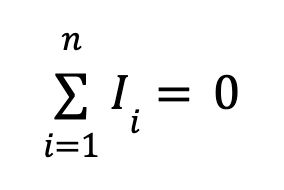
여기서 I 는 전류 값이고 n 은 노드에 공급되는 분기 수입니다.
2. 키르히호프의 전압 법칙(KVL)
루프 안의 모든 전위차(전압)의 대수 합계는 0이어야 합니다.
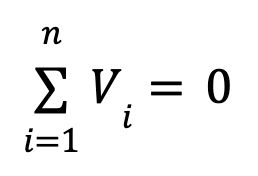
여기서 V는 전압이고 n은 루프 주변에서 전압이 측정되는 장소의 수입니다.
3. 옴의 법칙
도체를 통과하는 전류(I)는 도체의 전압(V)을 도체의 저항(R)으로 나눈 값과 같습니다.
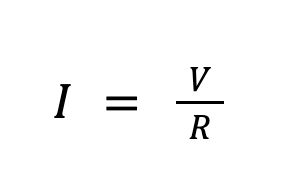
노드 해석 용어
노드 해석의 경우 회로 다이어그램은 다음 항목의 네트워크를 나타내는 데 사용됩니다.
참조 노드: 전압이 알려진 회로의 노드입니다. 이 노드는 일반적으로 접지 노드이며 전압은 0으로 설정됩니다.
비참조 노드: 전압을 알 수 없는 모든 노드
전압원: 알려진 전압에 의해 전위가 변화하는 회로의 부품
전류원: 알려진 전류를 가진 부품
수퍼노드: 전압원이 양쪽에 두 개의 알 수 없는 전압을 가지면 두 노드의 전류가 하나의 방정식으로 결합되는 수퍼노드로 변환될 수 있습니다. 그런 다음 수퍼노드의 전압-전류 관계에 대한 새로운 방정식을 작성할 수 있습니다.
컴포넌트: 전압과 전류 간의 관계가 알려진 전자 장치입니다. 저항기의 경우 그 관계는 저항을 기반으로 합니다. 이는 종종 어드미턴스 또는 저항의 역수로 표현됩니다. 커패시터의 경우 커패시턴스와 시간에 따른 전압 변화 간의 관계에 따라 관계가 달라집니다.
수정된 노드 해석: 더 복잡한 회로의 경우, 단순 노드 해석만으로는 알 수 없는 모든 전압을 찾기가 어려울 수 있습니다. 컴포넌트의 전류-전압 관계가 옴의 법칙보다 더 복잡한 경우 수정된 노드 해석을 수행합니다.
메시 해석: 전류를 알 수 없는 경우 키르히호프의 전압 법칙을 메쉬 분석에 사용하여 미지의 분기 전류를 찾습니다.
노드 해석이 중요한 이유
전자 회로는 전류를 전달하여 전력과 신호를 공급하도록 설계되어 있습니다. 회로를 설계하는 엔지니어는 정의된 전자 장치가 예상대로 작동하는지 알아야 합니다. 노드 해석은 회로의 모든 부분에 대한 노드 전압과 전류 흐름을 계산하기 위해 수행됩니다. 이렇게 기본적인 값을 알고 나면 신호 무결성, 발열 및 전체 전력 성능을 이해하기 위해 보다 복잡한 분석을 수행할 수 있습니다.
PCB 수준 설계의 경우 노드 해석을 사용하여 기판 토폴로지의 영향, 다양한 부품의 영향 및 접지 평면, 트레이스 및 비아와 같은 전도도 경로에서 전력의 전반적인 분포를 이해할 수 있습니다.
모든 종류의 마이크로칩의 경우 전력 손실을 이해하는 것이 더욱 중요해집니다. 노드 방정식의 수는 노드 수가 많기 때문에 중요해질 수 있습니다. 전류, 전압 및 전력의 분포를 이해하고 검증하는 것은 회로 해석을 통해서만 가능합니다.
노드 해석의 일반적인 또 다른 용도는 전압 강하 계산으로, 반도체 제품이 복잡해진 오늘날에는 특히 그러합니다. 노드 간에 전위가 떨어질 때마다 열이 생성되고 다른 곳에 필요할 수 있는 전력이 손실됩니다. 노드 해석 툴은 가장 복잡한 반도체에서도 원치 않거나 집중된 전압 강하로 인해 발생하는 회로의 약점에 대해 사용됩니다.
칩 설계자는 이 툴을 사용하여 문제를 찾는 것을 넘어 가정(what-if) 연구를 통해 전력과 성능을 최적화할 수 있습니다. 디지털 및 3D-IC를 위한 Ansys RedHawk-SC™ 전력 무결성 사인오프 플랫폼과 같은 툴은 대형 HPC Cloud 플랫폼에서 실행되어 최신 반도체 아키텍처에서 수백만 개의 부품이 포함된 대형 회로를 지원합니다. 신뢰할 수 있는 방법이라 다수의 주요 파운드리가 RedHawk-SC 소프트웨어를 사인오프용으로 인증합니다.
노드 해석을 수행하는 데 사용되는 단계
수작업으로 수행하든 소프트웨어에서 자동화하든, 노드 해석은 아래 절차를 따릅니다.
1. 노드 정의
회로(노드)에서 연결된 모든 전도성 세그먼트를 캡처합니다. 손으로 계산하는 경우 회로를 그린 후 노드에 번호를 매깁니다. 소프트웨어를 사용하는 경우 모든 노드 및 부품에 대한 연결 목록이 개요도에서 프로그래밍 방식으로 생성됩니다.
2. 접지 노드 선택
노드를 참조 노드로 선택하고 해당 전압을 접지 전압으로 정의합니다. 이렇게 하면 시스템에서 알 수 없는 정보의 수가 1개씩 줄어듭니다. n개의 노드가 있으면 n-1 방정식을 풀어야 합니다.
3. 변수 생성
전압을 알 수 없는 각 비참조 노드에 대해 해당 노드의 전압을 나타내는 변수를 지정합니다. 전압이 알려진 노드에는 변수가 필요하지 않습니다.
4. 노드 방정식 구성
전압이 알 수 없는 각 노드를 단계별로 살펴보고 해당 노드에 대한 KCL 방정식을 작성합니다. 이는 노드의 각 구간에 대해 계산된 분기 전류를 더하고 합계를 0으로 설정하는 것으로 구성됩니다. 전류원이 노드 사이에 있는 경우 두 노드 사이의 전류는 알려진 값이 될 수 있습니다. 노드 간의 전압 차이를 노드 간의 저항으로 나눈 값이거나 콘덴서의 전압 변화와 정전 용량 간의 관계일 수 있습니다. 다른 부품에는 더 복잡한 방정식이 있을 수 있습니다.
5. 노드를 수퍼노드로 결합
알 수 없는 두 전압을 슈퍼노드에 연결하는 모든 전압원을 단일 방정식으로 결합합니다.
6. 조합 및 계산
회로가 손으로 계산할 수 있을 만큼 작지 않은 한, 동시 방정식의 시스템은 n-1 열과 행으로 구성된 제곱 행렬로 재배열될 수 있습니다. 그런 다음 선형대수학 수치 해석을 사용하여 알 수 없는 전압을 계산할 수 있습니다.
노드 해석의 몇 가지 간단한 예
다음은 이 프로세스를 더 잘 설명하는 간단한 예입니다. 아래 그림은 전류원 1개, 전압원 10V 1개, 저항기 2개가 있는 회로입니다. 전압 V1은 알려져 있지 않습니다.
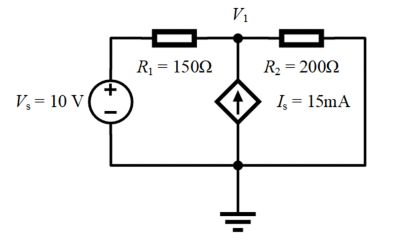
- V1은 알려지지 않은 유일한 전압입니다. 다른 노드는 접지되어 있으며 참조점이 됩니다.
- 노드 V1에는 세 가지 분기 전류가 있습니다.
- 저항 R1을 통과하는 전류: (V1 - Vs)/R1
- 저항 R2를 통과하는 전류: (V1 - 0)/R2
- 전류원 Is를 통과하는 전류: - Is
- 키르히호프의 전류 법칙에 따라, 이것들을 모두 더하여 0으로 설정합니다.

4. V1의 관점에서 다시 작성합니다.

이제 노드 해석법을 사용하여 알 수 없는 두 전압에 연결된 전압원이 있는 회로를 살펴보겠습니다.
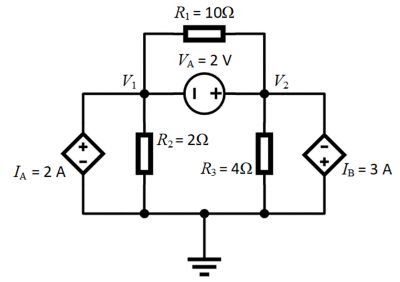
- V1 및 V2는 알 수 없는 노드 전압을 가집니다. 다른 노드는 접지되어 있으며 0V로 설정된 참조 노드가 됩니다. 또한 VA는 V1 과 V2 사이에 있으므로 수퍼노드입니다.
- 노드 V1에는 세 가지 분기 전류가 있습니다.
- 저항 R1을 통과하는 전류: (V1 - V2)/R1
- 저항 R2를 통과하는 전류: (V1 - 0)/R2
- 전류원 IA를 통과하는 전류: - IA 또는 2암페어
- 노드 V2에는 네 가지 분기 전류가 있습니다.
- 저항 R1을 통과하는 전류: (V2 - V1)/R1
- 저항 R2를 통과하는 전류: (V2 - 0)/R3
- 전류원 Ib를 통과하는 전류: Ib 또는 2암페어
- VA의 수퍼노드 방정식: V2 = V1 + VA
- 키르히호프의 전류 법칙에 따라 노드 1의 전류 흐름을 모두 더하여 0으로 설정합니다.

5. V1의 관점에서 다시 작성합니다.
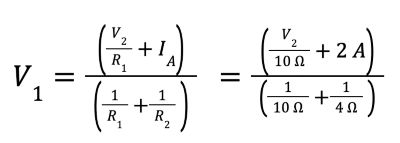
6. 키르히호프의 전류 법칙에 따라 노드 2의 전류 흐름을 모두 더하여 0으로 설정합니다.

7. V2의 관점에서 다시 작성합니다.
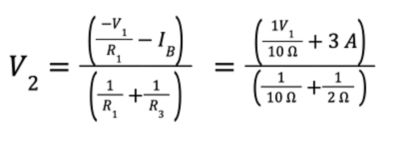
8. V2에 대한 수퍼노드 방정식을 사용하고 다른 두 방정식을 풀면 V1 = -7.33V, V2 = -5.33V가 나옵니다.
복잡한 전기 시스템의 노드 해석 시작하기
일반적으로 SPICE 솔버의 형태로 나타나는 노드 해석은 전기 회로의 동작 특성을 분석하는 기본 단계입니다. 브레드보드의 간단한 회로부터 수백만 개의 트랜지스터가 있는 업계의 최신 반도체에 이르기까지 엔지니어는 Ansys Totem™ 전력 무결성 사인오프 플랫폼과 같은 툴을 사용하여 전압을 계산할 뿐만 아니라 해당 정보를 사용하여 전력 노이즈를 이해하고 아날로그 혼합 신호 설계에 대한 신뢰성 사인오프를 달성해야 합니다.
Ansys Twin Builder® 소프트웨어는 다른 차수 감소 툴과 결합할 수 있는 완전한 노드 해석 솔버를 제공합니다. 이를 통해 하나의 인터페이스에서 회로와 제품에 연결된 내용을 분석할 수 있습니다.
다음은 복잡한 전기 시스템에 노드 해석을 효율적이고 성공적으로 적용하기 위한 몇 가지 제안입니다.
- 노드 해석 모델을 구성하기 전에 전기적 특성을 포함하여 설계의 모든 회로 요소를 이해합니다.
- 참조 노드에 대한 가정이 올바른지, 참조 노드가 제대로 접지되어 있는지, 전압이 부유할 수 없는지 확인합니다.
- ECAD 데이터를 원활하게 읽을 수 있고 회로 표현을 구성하기 위해 최소한의 사용자 입력이 필요한 툴을 사용하고 있는지 확인합니다.
- 노드 해석의 기초를 이해하는 데 시간을 할애합니다. 특성을 분석해야 하는 부품 유형과 관련된 간단한 회로 분석을 수행하는 자습서에 약간의 시간을 들입니다.
- 노드 해석 이상의 기능을 제공하는 소프트웨어 툴을 사용합니다. 주어진 회로의 노드 해석을 향후 시뮬레이션의 시작점으로 처리하는 솔루션으로 작업합니다.
관련 리소스
시작하기
엔지니어링 과제에 직면하고 있다면우리 팀이 도와드리겠습니다. 풍부한 경험과 혁신에 대한 헌신을 가지고 있는 우리에게 연락해 주십시오. 협력을 통해 엔지니어링 문제를 성장과 성공의 기회로 바꾸십시오. 지금 문의하기










